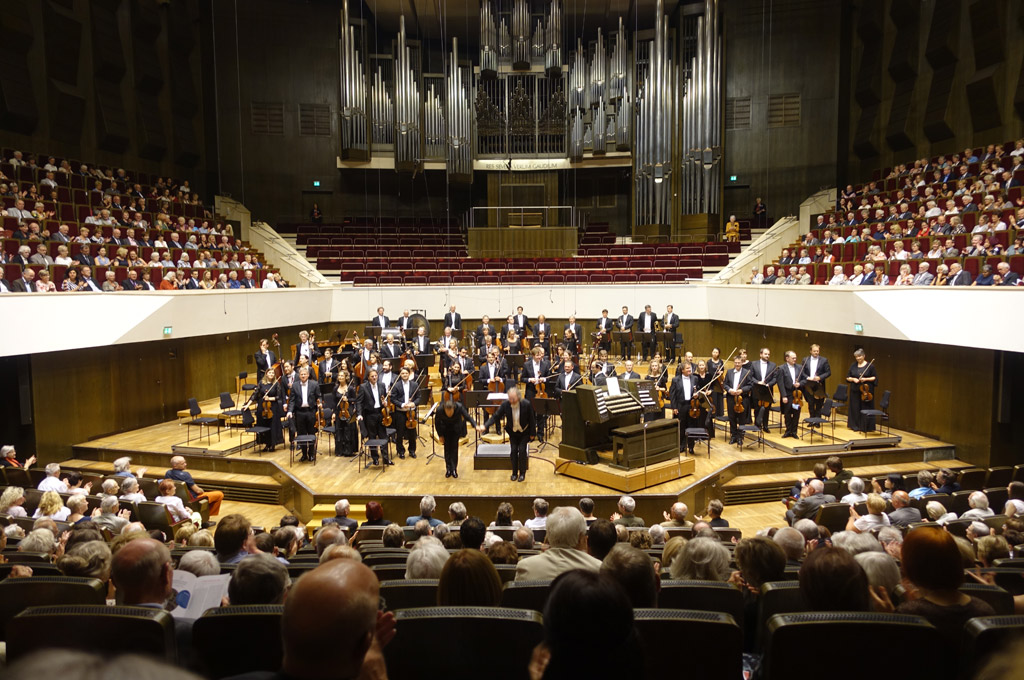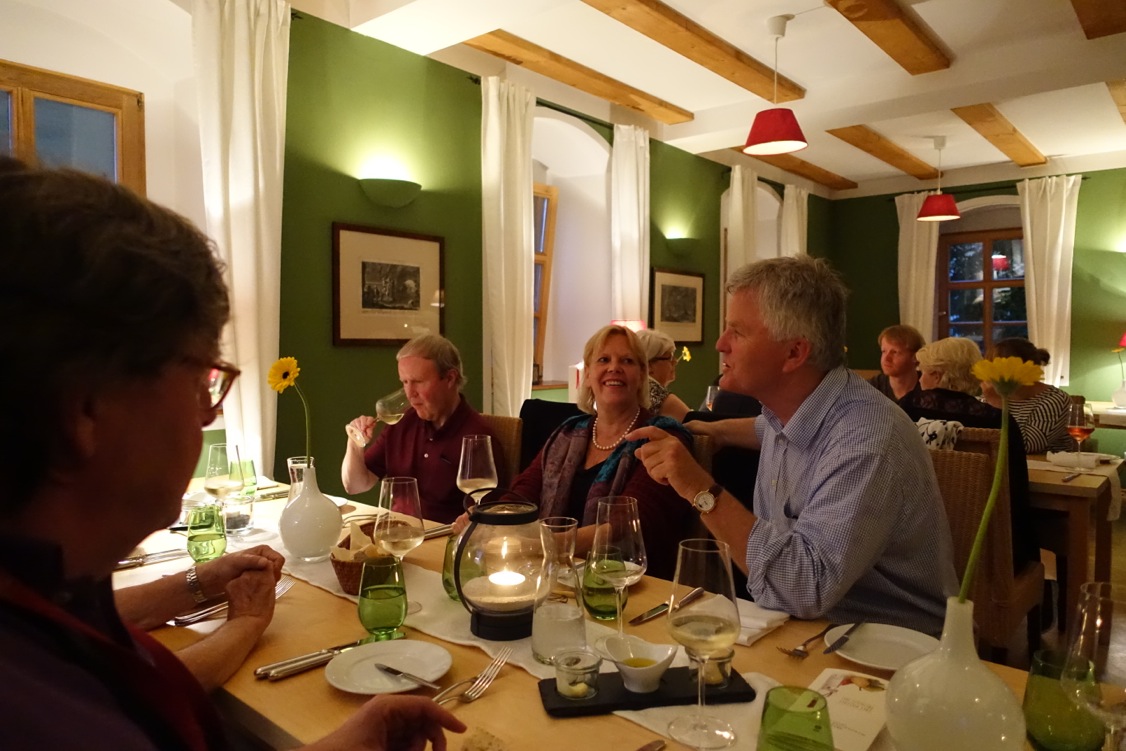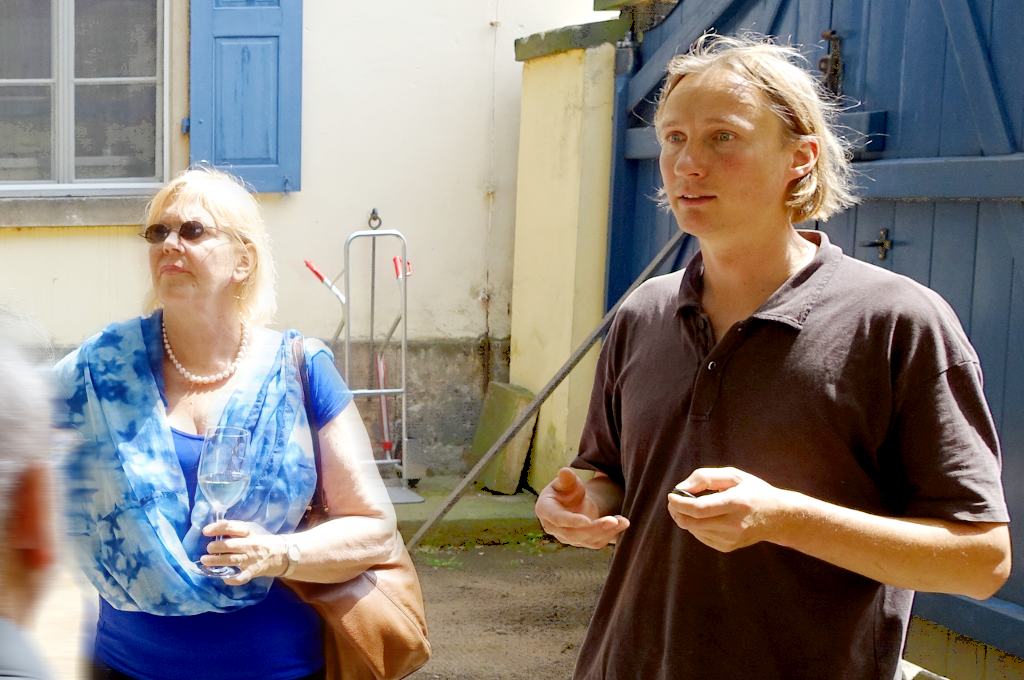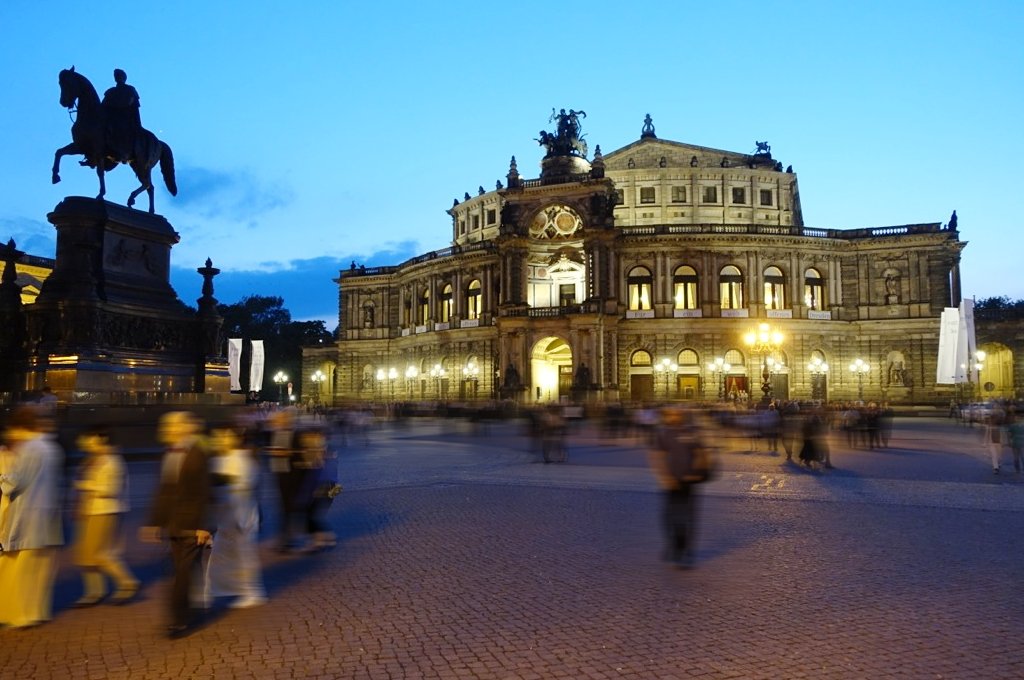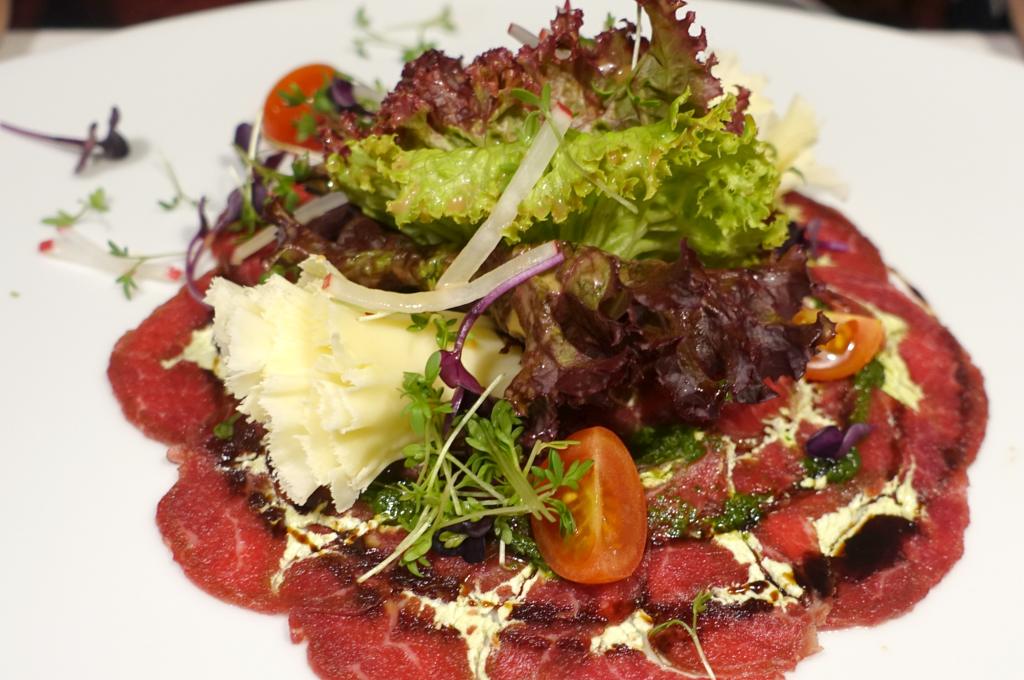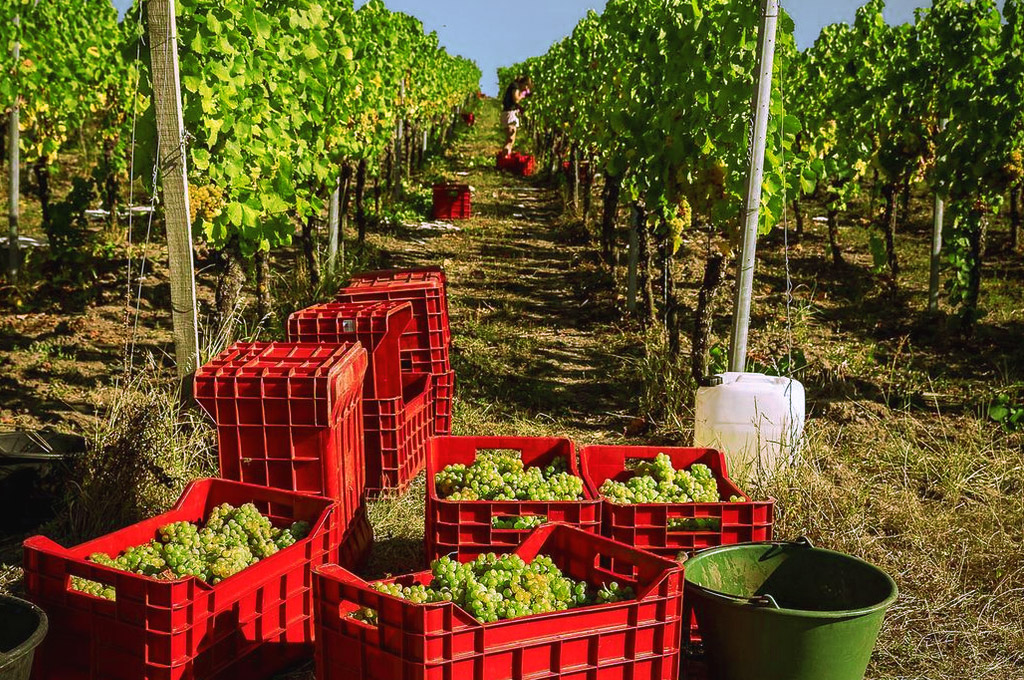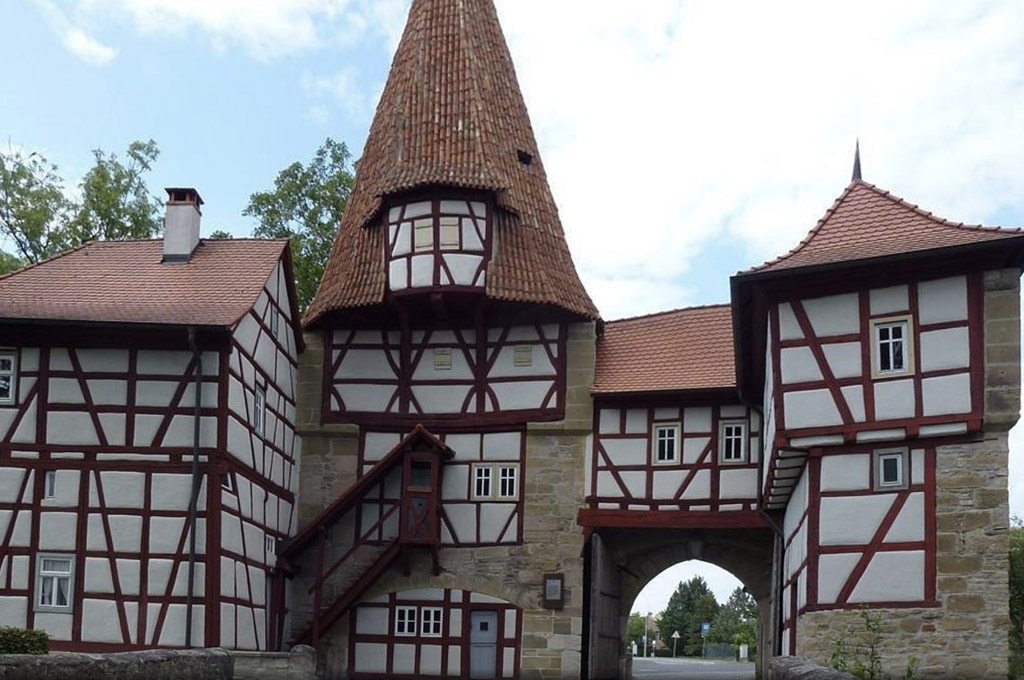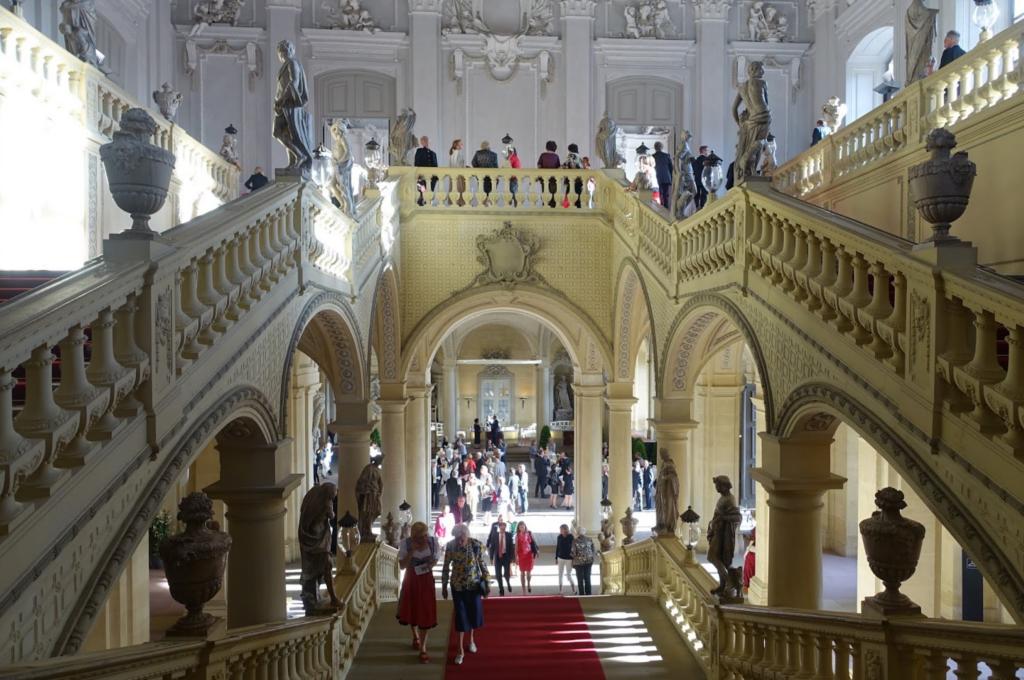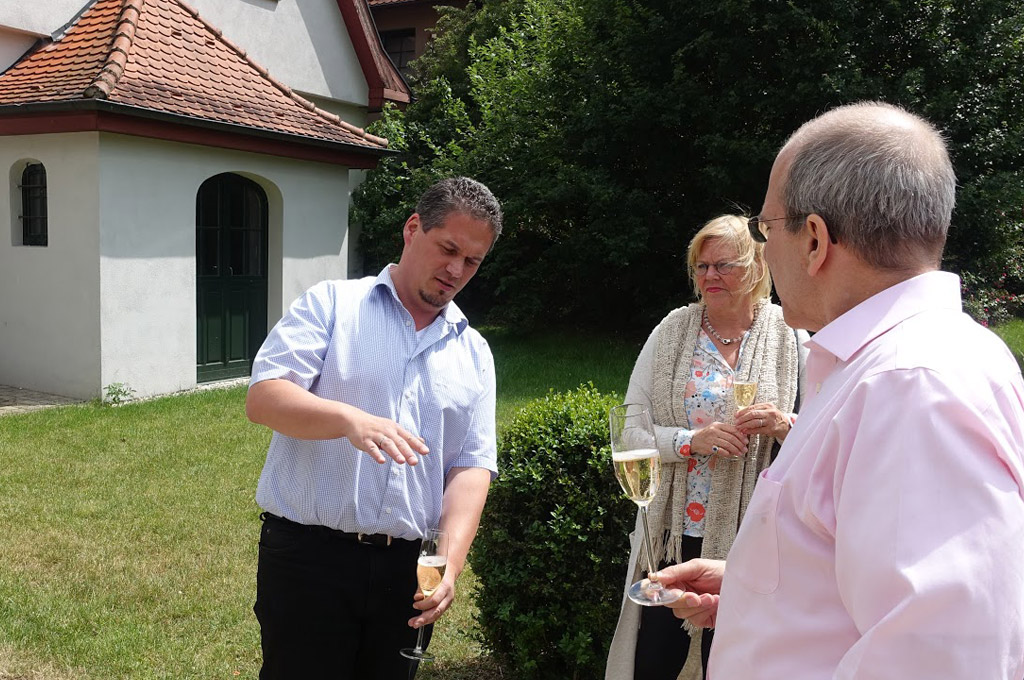A German Wine, History, Culture, and Music Tour
Discover Germany’s internationally fairly unknown wine regions east of Frankfurt and Germany’s intellectual and cultural cradle in “Mitteldeutschland”.
Spend 11 days touring four wine regions - the Saale-Unstrut, Sachsen, Württemberg, and Franken regions. Enjoy Berlin, Germany’s hip, and fascinating Capital. Discover the phenomenal red wines of Germany, in particular Lemberger (called Blaufränkisch in Austria)and Pinot Noir that gain more and more international recognition, as well as Württembergs great Rieslings, so different from the Rheingau and Mosel Rieslings. Discover Franken’s signature grape, the wonderful Silvaner grape. Find out about the many creative winemakers in the Saale-Unstrut and Sachsen regions, the wine regions in the former GDR, who produce outstanding cool-climate wines. Learn about the transition from a divided Germany to a unified country. Attend performances at world-renowned concert and opera houses, the Gewandhaus in Leipzig, and the Semper Opera in Dresden and enjoy the Mozart Festival in Würzburg.
|
Berlin • Saale-Unstrut • Sachsen • Franken • Württemberg Hildebrandt Organ Naumburg • Gewandhaus Leipzig • Semperoper Dresden • Mozart Festival Würzburg |
Monday, June 19 - Thursday, June 29, 2023
Accommodation: 10 nights:
Night 1: Monday, June 19Titanic Hotel in Berlin, a 4 star hotel at the Gendarmenmarkt, Berlin’s most prestigious central district close to the main artery: the Unter den Linden Boulevard, the Brandenburg gate, the Museum Island, the Berlin Opera, the government offices, the Brandenburg Gate. |
Nights 2 + 3: Tuesday, June 20 + Wednesday, June 21Hotel Zufriedenheit in Naumburg, a new 4 star, very elegant boutique hotel with stunning room designs in the heart of Naumburg. |
Night 4: Thursday, June 22Hotel INNSIDE in Leipzig, a brand new 4 star ultra modern hotel in a beautifully restored late 19th century building just next to J.B. Bach’s famous Sankt Thomas Church, and the historic city center. |
Night 5: Friday, June 23Parkhotel in Meissen, a beautiful, charming 4-star hotel built in 1870 in the art nouveau style with stunning views across the Elbe river to the Meissen cathedral and the impressive Albrechtsburg. |
Night 6: Saturday, June 24Hotel INNSIDE in Dresden, a very stylish, modern 4-star hotel with innovative design in the heart of the city with the Twist Sky Bar on the 6th floor that allows for a spectacular panoramic views of the golden, magnificent dome of the rebuilt Frauenkirche. |
Nights 7 + 8: Sunday, June 25 + Monday, June 26Hotel Greifensteiner Hof in Würzburg, a 4 star hotel with an old-world elegance in the historic center of the Barocke town Würzburg. |
Night 9: Monday, June 27Hotel Lamm Hebsack in Remshalden, a family-run, very cosy hotel with a long tradition of hospitality, a very warm welcome, and a good restaurant. The hotel in the small village of Remshalden is beautifully located between vineyards and orchards. |
Night 10: Tuesday, June 28Hotel zum Alten Rentamt in Schwaigern, a family-run, historic hotel, part of the Count von Neipperg Estate, with an elegant, refined interior and cultivated hospitality. |
DAY 1: Monday, June 19
AFTERNOONMeet & Greet in the lobby of our hotel.
|
|
|
Guided city tour in Berlin.
The “Berlinflüsterer - Berlin whisperer”Arvid Zemkus gives us a thorough insider tour of Berlin. Lean about Berlin, Germany’s largest city, historic and new capital, a divided city for more than 40 years and toady a vibrant, hip, artsy, spontaneous, food lovers paradise, lively city along the Spree river.
|
|
|
Visit and tasting at Weingut Herr & Frau Lüttmer, Die Winzerei in Berlin.
I let them speak about themselves: “With lots of enthusiasm and passion in our luggage we city dwellers travelled the wine regions to find our luck in viticulture. As career changer with plenty of ideas we were looking for suitable vineyards. Italy, Mosel, Hessen?, not really around the corner from Berlin where we live. After two years of searching, we discovered 1 acre on the Weischützer Nussenberg vineyard in the northern Saale-Unstrut wine region which had been fallow for some time. Perfect location! Good climatic conditions made it possible to plant red grape varieties. In 2008 we planted Blauer Frühburgunder (early ripening Pinot Noir variety) -Pinot Noir Précoce- on the shell limestone. We focus on quality instead of quantity. To bring back balance into the soil we use conventional but also alternative methods. Growth, the canopy, the fruit, everything is regularly checked by us and we work entirely manually.” Today they also own 1.5 acres in the Vitzenburger Schlossberg, a very steep vineyard (see picture) with an inclination of 40 – 65%, which they recultivated and planted with Riesling and Pinot Noir Précoce. Pinot Noir Précoce is their baby, a diva and a lot of attention needs to be paid to the grape to make a great wine. The Lüttmer wines regularly get awards form acclaimed wine critics such as Stuart Pigott, the British/German wine critic for James Suckling. |
EVENINGDinner and wine at restaurant borchardt in Berlin.
The “borchardt” is a Berlin institution. Politics, Press, Diplomats, ... it is here where they mingle over a perfect “Schnitzel”, “Tatar Brot” or other very well executed German dishes. The borchardt looks back on a 150-year history. It was in 1853 that August F. W. Borchardt laid the foundation for a new dining culture that remains intimately associated with Berlin today. The main site of the borchardt restaurant in Französische Straße supplied the Kaiser in the Wilhelmine era and went on to survive the Second World War and the city’s division by the Berlin Wall. |
DAY 2: Tuesday, June 20
MORNINGGuided visit of Sanssouci in Potsdam
We all know about Frederick the Great, arguable the most important and beloved King of Prussia. To escape the formal ceremonies and pomp of the Berlin court he built a summer palace “Sanssouci” -basically more like a large, single-story villa than a palace- in Potsdam, outside of Berlin. Frederick the Great was very modern in his thinking and an aficionado of the arts and fine living. He dreamt about planting a vineyard in Potsdam and after finishing the construction of the “New Palais” in Potsdam in 1769 he set out to create beautiful gardens and a terraced vineyard “Königlicher Klausberg” on the slopes of the hill Sanssouci sits on. There was varied success in harvesting good grapes and after 1945 most of the buildings and gardens were destroyed by the Russian Army. During GDR times Sanssouci was renovated but the gardens and the vineyard were not really taken care of. After reunification in 1989 besides restoring historical buildings the focus also shifted to the gardens and the vineyard. The project “Königlicher Klausberg” started revamping the vineyard and initially planted 2000 vines of the varieties Regent and Cabernet Blanc. In his will Frederick the Great wrote that he wanted to be buried in the vineyard of Sanssouci but the twists and turns of history had it that he finally came to rest on Hohenzollern Castle in Württemberg. On August 17, 1991 (the fall of the Berlin wall in 1989 made it possible) on the 205th anniversary of his death Frederick's casket lay in state in the court of honor at Sanssouci, covered by a Prussian flag and escorted by a Bundeswehr (German Army) guard of honor. After nightfall, Frederick's body was finally laid to rest in the terrace of the vineyard of Sanssouci – in the still existing crypt he had built there – without pomp, in accordance with his will. |
|
|
Visit of the estate Villa Jacobs and their vineyards in Potsdam, Brandenburg. |
LUNCHWine pairing lunch at Villa Jacobs.
We will enjoy a beautiful luncheon in the park next to the vineyard (weather permitting) accompanied by Villa Jacobs wines. Our host will be owner Marianne Ludes. |
AFTERNOONVisit and tasting at Weingut Günter Born in Salzatal, Saale-Unstrut.
The Saale-Unstrut wine region sits on 51st latitude and is Germany’s northernmost accredited wine region, located in the valleys of the Saale and Unstrut rivers, an area of the former German Democratic Republic (GDR). This is a historic wine producing region. Cistercian monks came from Burgundy and planted the first vines more than 1000 years ago. The oldest record of viticulture dates back to the year 998 during the reign of Emperor Otto III. The winery Günter Born is located in the northernmost tip of the Saale-Unstrut region in the Mansfeld lake area. The protective Harz mountains and the heat reflective surface of the water produce a fantastic microclimate. The colored sandstone soil with its layers of loess-loam serves as a heat reservoir. The viticultural history of the Born family goes back to the mid 19th century. In 1990 shortly after reunification private ownership became again possible and Günter Born founded one of the first privately owned wineries in this region. Today the winery has 20 acres of vineyards and is managed by Günter Born and his daughter Elisabeth. Elisabeth studied oenology at the famous Geisenheim oenological university and gained experiences in New Zealand and South Africa. In 2011 she served as the German Wine Princess. |
EVENINGArrival and check-in at Hotel Zufriedenheit in Naumburg.
|
DAY 3: Wednesday, June 21
MORNINGVisit and tasting at Landesweingut Kloster Pforta in Bad Kösen, Saale-Unstrut.
This winery is one of the five State-owned wine producing estates in Germany, and is owned by the State of Sachsen-Anhalt. Its history mirrors German history. Its origins date back to the Pforta Abbey, founded in 1137 by Cistercian monks. In 1154 the monks started to plant vines in the Pfortenser Köppelberg vineyard, which still today is one of the six vineyards of the winery, producing excellent wines. Pforta Abbey soon had a reputation as the richest abbey in medieval Thuringia, with vineyard holdings in 192 communes, totaling at least 250 ha (around 625 acres). After Reformation (during the 16th century the eastern part of Germany became Lutheran and the monks had to leave), ownership went to the kings of Saxony, which subsequently lost the Abbey Pforta to the Kingdom of Prussia at the Vienna Congress in 1814. After World War II, it became the socialist co-operative VEG (volkseigener Betrieb / company owned by the people) Weinbau Naumburg in the GDR, with 300 acres of land. After the fall of the Wall in 1989, Abbey Pforta was in the hands of the privatization organization Treuhand for a few years, but privatization efforts were not successful and thus the State of Sachsen-Anhalt took over. The winery still operates in the historic buildings, and we will indulge in the beautiful view across the Saale river and surroundings steeped in an almost 1000 year long story. |
|
|
Organ concert and guided tour of the Hildebrandt organ in the St. Wenzels church in Naumburg.
We will learn everything that there is to know about an organ from our expert guide, Florian Zschucke, who is the organist of the St.Wenzels church. The 1746 Hildebrandt Organ in St. Wenzel’s Church in Naumburg, is the best example of a “true Bach organ” and belongs to the most significant creations of late baroque organ building. The organ of 52 stops was built by Zacharias Hildebrandt under the influence of Johann Sebastian Bach. Bach made sure that this organ corresponds to his idea of an excellent large organ. He examined the organ, certified that Hildebrandt’s work was good, and played the finish organ. In 1748 Bach’s son in law became the organist at the St. Wenzel’s church. |
LUNCHLunch at restaurant Café Kanzlei on the market square in Naumburg just around the corner from the St. Wenzels church.
|
AFTERNOONVisit and tasting at Weingut Hey in Naumburg, Saale-Unstrut.
This is an up and coming winery recognized for its stellar Rieslings and white wine cuvées. It all started in 2001, well after German reunification when Sigrun and Reinhard Hey bought a once exquisite vineyard in the steep slope site “Naumburger Steinmeister” including the farmhouse at the foot of the vineyard. With dedication the totally overgrown vineyard was reclaimed by removing blackberry bushes that had almost suffocated 80 year old vines, rebuilding the terraces, and planting new vines. Today the Hey winery possesses 13 acres of top vineyards. Son Matthias, who graduated from the enological university in Geisenheim in 2008 is now at the helm and puts the emphasis on top quality and the uniqueness of the region. He is also member of the “Breitengrad 51”, an association of young winemakers of the Saale-Unstrut region. Their aim is to produce Saale-Unstrut Rieslings of world-class quality and to put the region on the map as top wine producing cultural heritage destination. |
EVENINGWine pairing dinner with wines from Weingut Hey at restaurant Zufriedenheit.
The Hotel and Restaurant Zufriedenheit opened in 2017. The restaurant almost immediately got recommended in the Michelin guide for Germany and received 14 points in the Gault & Millau restaurant guide. This is something highly unusual and speaks for the outstanding quality of the chef. The kitchen presents local and seasonal dishes of very high quality and with innovate new ideas. We will have wines of winery Hey perfectly matching the courses. Matthias Hey, the vintner himself will be with us, and will talk about his wines, and why this wine goes well with this particular dish. I am sure that this will be a very memorable evening. |
DAY 4: Thursday, June 22
MORNINGSelf-guided visit (audioguide) of the Naumburg Cathedral.
This impressive late Romanesque and Gothic Cathedral is one of the most important cultural monuments of the High Middle Age period in all of Europe. The ensemble of Romanesque and Gothic artwork in the cathedral is unique and gives the visitor an understanding of middle age liturgy found nowhere else. World-renowned are the “Naumburger Meister”, the stonemasons that sculptured beautiful figures such as the donor portrait of Uta von Naumburg. |
|
|
Visit and tasting at Weingut Böhme und Töchter, Saale-Unstrut.
Viticulture began in 1986 as a sideline at the Frank Böhme winery in Gleina with the recultivation of an old vineyard near Dorndorf an der Unstrut. Initially they were only concerned with the cultivation, eleven years later they dared to press and develop their wine themselves. The family has been running the Böhme winery in Gleina as their main occupation since 2003 with great success. Today three generations of the family run the winery. They cultivate 10 acres of vineyards, on which 14 different grape varieties are grown. As regional wine queen of Saale Unstrut, Marika Böhme represented the wine-growing region in 2007/2008. In addition to numerous awards at the Saale-Unstrut state wine awards, the Böhme winery was able to achieve the coveted entry in the "Gault Millau" wine guide Germany in 2011 and became member of the VDP in 2022. "The place where our best wines mature is the Freyburger Schweigenberg. The picture changes from plot to plot, sometimes from row to row, wild orchids grow here, wild thyme there. The steep southern orientation and rich mineral wealth of the shell limestone are perfect for the grape varieties that are close to our hearts: Pinot Blanc, Chardonnay, Riesling and Pinot Noir. In the Schweigenberg they are in top form. We value tradition. In addition to working with steel tanks, we rely more and more on long maceration times, spontaneous fermentation, oak barrels in the cellar - and on our gut feeling. This is rewarded with wines that tell of the microclimate and the soil of our vineyards” the Böhme family says. |
LUNCHLunch at Landgasthof Baumenroda in Gleina-Baumenroda. |
AFTERNOONGuided Visit and tasting at Weingut Buddrus in Laucha an der Unstrut, Saale-Unstrut.
The wines of Konni (Konrad Budruss) and Evi (Eva-Maria Wehner) are among the very few wines from the Saale-Unstrut region available in the US. Konni learned about winemaking in Bad Kreuznach (Nahe region), Würzburg (Franken region) where he met Evi, New Zealand and in Austria. Evi and Konni started looking for some vineyards where they could pursue their dream producing their own wine. In 2016 they found a small plot in the Saale-Unstrut region, just south of the Grand Cru site ‘Hohe Gräte’. This plot was so hard to work that it was spared the adaption of the vineyards for mechanization during the GDR times. Today they have 8,5 acres of vineyards in different, prestigious spots in the Saale-Unstrut region. All parcels are unique gems scattered in a 30 kilometer circle and are worked organically and biodynamically. Their wines are razor sharp with pronounced acidy yet balanced. I quote Stephen Bitterolf, owner of vom Boden imports: “If there was an Oscar or a Grammy or some prestigious award given for ‘heroic winemaking in the face of outrageous obscurity,’ I would submit this young couple." |
|
|
Arrival and check-in at INNSIDE Hotel in Leipzig. |
|
|
Guided walking tour through Leipzig. |
EVENINGGewandhaus Leipzig.
Concert with the full Gewandhaus orchestra: Antonin Dvorák, Detlev Glanert Conductor: Semyon Bychow |
DAY 5: Friday, June 23
MORNINGVisit and tasting at Weingut Martin Schwarz in Meissen, Sachsen.
Martin Schwarz belongs to the group of ambitious winemakers in Sachsen. Back in the days when sipping a 1975 Château Margaux on a park bench while skipping Latin classes at school he got hooked to the world of wine, and decided to make wine his profession. He interned at the VDP winery Dr. Heger in Baden to get some practical experiences under his belt. In 1996 he graduated from the famous Geisenheim Oenological University in the Rheingau. A prominent winery in Sachsen was looking for a cellar master and Martin took on that challenge. For 16 years he worked as winemaker at the VDP winery Schloss Proschwitz before he started out on his own in 2013. Today he owns 5 acres in one the best vineyards sites on the steep slopes of the Elbe river. His wines show a very individual character and convince with their complexity and finesse. In 2020 he was invited to join the VDP. |
LUNCHLunch with wine pairing at restaurant / winery Vincenz Richter in Meissen.
The winery and wine restaurant was founded in 1873 by Vincenz Anton Richter. It survived the GDR times and Thomas Herrlich is now the 4th generation of the founding family to manage the business. The cozy restaurant is in a beautiful 500 year old half-timbered building in the historic city center of Meissen. I am sure that Thomas Herrlich (he loves to talk and it is very interesting to listen to him) will join us for part of the luncheon and will have us listening to music and will talk about his wines and their connection to Music. |
AFTERNOONArrival and check-in at the Welcome Parkhotel in Meissen, Sachsen.
Enjoy the view across the Elbe river on the breathtakingly beautiful, historic city of Meissen with the mighty Albrechtsburg castle. The Albrechtsburg is a late Gothic castle built in the 15th century, and Germany’s oldest castle. It sits majestically on a rock above the Elbe river and presents together with the cathedral of Meissen a gorgeous panorama. Later the castle was superseded by the Dresden castle as the new seat of the Wettin dynasty which eventual produced the kings of Saxony and Poland. It was here where the King Augustus II the Strong of Saxony established the first European Porcelain manufacture in 1710 under the supervision of Johann Friedrich Böttger. The world-famous Meissen porcelain was produced at the Albrechtsburg until 1863, when the location became too small and the manufacture moved to its present location in Meissen. |
|
|
Guided visit of the Porzellanmanufaktur in Meissen.
We will see close-up how the world-famous Meissen china and porcelain figurines are made. |
Visit and tasting at Weingut Schloss Proschwitz, Prinz zur Lippe (VDP) in Meissen.
The Prinz zur Lippe family was first mentioned in the early 12th century and belonged to the reigning dynasties in Europe until 1918. For more than 300 years, the family branch of Georg Prinz zur Lippe, owner of winery Schloss Proschwitz, lived in Sachsen and produced wine. However there is a 45 year long interruption, when in 1945 the Russians occupied the eastern half of Germany, and disappropriated and expelled the family. Immediately after Germany’s reunification Georg Prinz zur Lippe started to buy back his family’s wine estate and ancestral residence, the Proschwitz castle. Since then he has restored the castle to its former glory, and invested heavily to build up the winery to become a state of the art wine producing estate. With 220 acres under vine the estate belongs to one of the larger wineries in Germany and is the largest privately owned one in Sachsen. Great care is given to sustainable techniques in the vineyard to enable future generations to continue to produce outstanding wines. Prinz Georg zur Lippe will be our host. |
EVENINGWine pairing dinner at Lippe'sches Gutshaus, Schloss Proschwitz.
The regional, fresh cuisine with a sophisticated twist – a perfect pairing with the Schloss Proschwitz wines - received the Chaîne des Rôtisseurs award in 2011. Georg Prinz zur Lippe will be our host. He will share with us his story how he rebuild the castle and the winery after reunification. He will also perfectly pair the meal with his wines. |
DAY 6: Saturday, June 24
MORNINGVisit and tasting at the Sächsisches Staatsweingut Schloss Wackerbarth in Radebeul, Sachsen.
The Baroque Wackerbarth castle was built in 1727 by Count August Christoph von Wackerbarth. The castle looks back on a volatile history and changed hands multiple times. In 1928 a wine estate was founded at the castle, which even survived the GDR times. During GDR times it became a socialist co-operative VEG (volkseigener Betrieb / company owned by the people). Along the Radebeul vineyards, where counts once resided and the court of Augustus the Strong used to hold glittering parties, today there is an ultra modern winery owned by the State of Saxony, who took over the castle, grounds, and vineyards after reunification. The contrast between a “Napa” style wine estate and a Baroque castle is unique. The Schloss Wackerbarth wines benefit from very favorable climate conditions. The Elbe river dampens the harsh winters and the vineyards are on steep sun-kissed slopes. Schloss Wackerbarth is famous for its Sekt, produced according to the méthode Champenoise. |
LUNCHLunch with wine pairing in at Weingut Karl Friedrich Aust in Radebeul, Sachsen.
The origins of the “Meinholdsche Turmhaus” (tower building), the heart of the winery Aust, dates back to the year 1650. Wine was already made here in the 18th century. The Aust family was able to purchase the old estate in 1975 and restored this historical gem on their own initiative. However, during the communist era they were only allowed to produce 100 liters of wine for their own consumption. The fall of the Iron Curtain in 1989 opened unforeseen opportunities. The new situation allowed the Aust family to cultivate their own 13 acres of vineyards, and the winery Karl Friedrich Aust was born. Karl Friedrich trained at prominent estates to learn the art of making wine and has now become a top wine maker in his own right. The winery also has a restaurant on its premises and serves wonderful local food with a modern twist. |
AFTERNOONArrival in Dresden and check-in at INNSIDE hotel.
The hotel is located right the historic part of Dresden, around the corner from the famous Frauenkirche. |
Visit and tasting at Weingut Stefan Bönsch in Dresden, Sachsen.
I let Stefan Bönsch speak: “In 2013 we started out as the typical garage winery. We sorted the grapes in our courtyard, processed them in adjoining rooms, expanded the cellar and put two large fermentation tanks in the garage for the 2016 vintage. At some point we reached our absolute capacity limit. Just at that moment we were offered an old inn. Since 2017 we produce out wines of the former "Zum Kellerberg" inn. There is room for ideas, storage space for stainless steel tanks and a historic vaulted cellar in which our red wines are allowed to mature in Saxon oak barrels”. Stefan Bönsch is a trained cooper and winemaker. He got his expertise at Schloss Wackerbarth, at the very prestigious winery Umathum in the Burgenland in Austria and later at Winery Martin Schwarz in Meissen. Stefan Bönsch also graduated with a master's degree as a wine cooper at the renowned wine school in Weinsberg. With a passion for his work and expertise, he cultivates a total of 5 acres of vineyards, which are divided between the historic vineyards in Niederwartha, a vineyard in the Meißner Rauhental and a steep slope in the Radebeuler Lößnitz. These sites are planted with Riesling, Traminer, Pinot Noir, Scheurebe and Pinot Gris. His wines are highly rated in the Vinum and Gault-Millau wine guides. |
EVENINGWe do a sightseeing walk to the Semperopera via the "Brühl'sche Terrassen" on the banks of the Elbe river. Soak in the magnficent architecture. No wonder that Dresden was once called the "Venice" of Germany.Semperoper Dresden.
Opera: "Nabucco" by Giuseppe Verdi. |
DAY 7: Sunday, June 25
MORNINGVisit of the Royal Palace in Dresden and the museum complex.
To look at the treasure in the museum leaves you speechless and you get a sense of what Dresden was before WW II. Dresden has a long history as the capital of the kingdom of Saxony. For centuries the Saxon royals spared no money and effort to furnish the city with artistic, and cultural splendor. The baroque and rococo city center, and wealth of art, gave the city the nickname: “Florence of the north”. In modern times, until 1933, Dresden was Europe’s capital of modern art. The allied bombing at the end of World War II wiped out the city, and the city will never be able to shed the scars and to return to its former glory. During GDR times very few of the most important historical monuments were restored. After reunification restauration efforts intensified, and major reconstruction projects, including rebuilding the “Frauenkirche”, were completed. The restoration of the Royal Palace is about to be completed. We will visit the “Türckische Cammer” (Turkish Chamber). This is one of the oldest and most important collections of Ottoman art anywhere in the world outside Turkey. The largest object in the Türckische Cammer, which opened in 2010, is an Ottoman three-mast tent – a 20 m long, 8 m wide and 6 m high dream made of gold and silk. Only in Dresden is it possible for visitors to enter such a tent and examine the supreme craftsmanship of Ottoman textile artists at close quarters. We will also visit the “Historisches Grünes Gewölbe” (Historic Green Vault), to get a glimpse into the late baroque world of the Saxon royals. The Green Vault was reopened on the ground floor in 2006. From 1723 to 1730, August the Strong had a series of rooms constructed to represent his wealth and power as an absolute monarch; the full, incredible experience of this late baroque synthesis of the arts is once again available to visitors in the original rooms. You have to see this with your own eyes. No picture will ever be able to capture the luxury and splendidness of these rooms. |
LUNCHLunch at Gasthaus Krauß, Auenthalstube in Jodtz, Bayern.
|
AFTERNOONVisit of the Deutsch-Deutsches Museum Mödlareuth, Töben, Thüringen / Bavaria.
We will experience recent German history. We see here how the border between West Germany and the GDR affected people on both sides of the fence. This small town of a population of 50 souls was divided just like Berlin. The tiny river Tannbach became the official border when Germany was divided up into 4 sectors after WW II. Unfortunately the Tannbach river happens to flow just through the middle of town, so one side of the river belonged to the American sector, which later became together with the French and British sector the Bundesrepublik Deutschland, and the other side belonged to the Soviet sector, which eventually became the GDR. In 1952 the GDR started to construct a 3.60 meter high wall, and watch towers. Until 1989 the divided families could not even greet each other or wave. |
Ristorante Rossini in Estenfeld, Franken.
We stop here to enjoy some Italian food, a change from the German fare. After dinner it is just a short hop to our hotel n Würzburg. |
|
|
Arrival and check-in at Hotel Greifensteiner Hof in Würzburg.
This hotel has the best location in all of Würzburg. It is right in the center of the beautiful old town, but on a quiet side street. The evening is free for you to relax after the long drive or explore Würzburg and take a short walk to the Alte Mainbrücke -a smaller version of the Karlsbridge in Prague- with stunning views of the Marienberg fortress on the hill across the Main river and towards the famous Würzburger Stein vienyard. |
DAY 8: Monday, June 26
|
We are now in Germany’s Franken wine region, in ‘Silvaner’ country. With delicate vegetal aromas and moderate acidity, Silvaner wines are perfect pairing for the white asparagus that emerges from the earth to fill German grocery stores and market stalls annually between April and June and graces lunch and dinner tables literally every day during that period. There is a young generation of winemakers that consider Silvaner as a national counterpoint to Burgundian Chardonnay or Saumur Chenin Blanc. |
|
|
MORNINGVisit and tasting at Weingut Seufert in Iphofen, Franken. |
|
|
Visit and tasting at Weingut Wirsching (VDP) in Iphofen, Franken.
The Wirsching family has been producing wine since 1630 in the village of Iphofen. It is one of the largest privately-owned wineries in Germany. In the early 1960s two brothers Hans Wirsching jr. and Dr. Heinrich Wirsching ran the estate. Hans Wirsching Jr. was focusing on winemaking and Dr. Heinrich Wirsching on all other aspects. Thanks to their dedication to Iphofen's vineyards, Iphofen has developed into one of the leading wine-growing communities in all of Franken. The 'new style' that Hans Wirsching had given his wines - fresh, reductive, elegant and slim - has become a trademark. The early passing of Hans in 1990 did not change the qualities that make Wirsching wines special. Face of the winery is Andrea Wirsching, daughter of Dr. Heinrich Wirsching. Together with her younger half-sister Lena they are carrying on the 350-year family wine making tradition. The iconic Iphöfer Julius-Echter-Berg is one of Franconia's prime vineyard sites. Its namesake is the famous Prince Bishop Julius Echter of Mespelbrunn. Hans Wirsching Sr. is considered 'The Father' here, because in the early 1920's it was his idea to name the best vineyard site of Iphofen 'Julius-Echter-Berg'. |
LUNCHGenußhaus Iphofen on the historic market square.
|
AFTERNOONVisit and tasting at Weingut Weltner (VDP) in Rödelsee, Franken.
The Weltner family can trace back its roots as winemakers to 1553; for four generation in Rödelsee. Since 2005 Paul Weltner is at the helm of the wine estate of 28 acres. He was well prepared when he took over the responsibility: after an apprenticeship as a cooper and a training in Burgundy and at Weingut Ökonimierat Rebholz, one of the best of the best wine estates in Germany, he graduated as viticultural technician from the renowned Weinsberg school of viticulture. He produces wines that are demanding. They are individualistic and challenging. The focus is on Silvaner. The unique vineyard site ‘Rödelseer Küchenmeister’ is the perfect location for this grape: it has such a geological variety. There are different layers of gypsum keuper, clay, slate, shell-limestone, sandstone. I quote the Vinum Weinguide November 2022: “For a while already Paul Weltner is at the very top in Germany’s wine landscape, and that's a good thing. It's hard to imagine life without him up there, with reliable calm and serenity, he delivers wines that show such brilliance, minerality and depth that you actually want to buy everything without tasting. And we know how well his wines can mature, so feel free to put it away. Above all, his Silvaner, grown on the gypsum keuper typical of Rödelsee, makes it clear that he always has to be on the list when it comes to the best of this kind in Germany.” |
EVENINGMozart Festival Würzburg: Concert in the Imperial Hall at the Würzburg Residenz:Bamberger Symphoniker: Conductor Fabio Biondi; Oboe Barbara BodeMozart: Finale 'Ascanio in Alba'; Sinfonie Nr 10 D-Dur; Mendelsohn Bartholdi: Sinfonie Nr 1; Sammartini: Oboe Concerto D-Dur
The Würzburg Residenz is one of the largest palaces in Europe and one of the most homogeneous and most extraordinary Baroque castles. The palace was built in 1720 by the Prince Bishop, Johann Philip Franz von Schönborn who wanted to construct a residence worthy of his position as absolute monarch. Among other gifted artists and craftmen he hired Giovanni Battista Tiepolo, the greatest fresco painter of the 18th century to paint the ceiling of the grand staircase. The artists and craftmen decorated the residence in a joint creative undertaking and created the Würzburg “Rococo”, the most exhuberant of all the variations of this style in Germany. In 1814 Würzburg became part of the Kingdom of Bavaria. The Bavarian king made Munich the capital and his residence. Thus Würzburg was no longer a center of power. |
DAY 9: Tuesday, June 27
MORNINGVisit and tasting at Weingut Rudolph May (VDP) in Retzstadt, Franken.
Rudolph May cultivates 40 acres of vineyards in the Eberstal, a small side valley of the Main river north of Würzburg. This is a very young wine estate by German standards: It was only in 1998 that the estate was established from a small, part-time wine grower operation. 60% is planted with Silvaner on barren shell-limestone soils – a very different geological basis than the Iphofen and Rödelsee vineyards. The May family also makes a fantastic Pinot Noir. Vineyard work is done without machines, and in harmony with nature. Since 2016 the vineyards have been certified organic by Naturland. Rudolph May says about his wines: “We are enthusiastic about the Silvaner, which can develop its character in a unique way in Franken. Barren and skeletal soils make our wines very dry and rich in finesse. That's when you discover their origin and not a lush bouquet of fruit. We work according to the guidelines of organic viticulture. We stay away from anything that could be called manipulative. With 100% grape quality, we can afford to leave the must in the cellar to controlled idleness. Because we want to taste what nature has created.” |
|
We are leaving the Franken region and drive to Württemberg. The Württemberg wine region still remains one of the country’s least known viticultural areas despite its size. It is with 27,000 acres the fourth largest wine region and red wine country (75% red). Before WWII, a lot of the grapes were sold off to the local co-op and the majority of wine production was consumed by locals. It was only over the course of the last twenty years that wines from the region became distributed around Germany and ultimately started to get exported to the rest of the world. |
LUNCHWine pairing lunch with Fürst Hohenlohe-Öhringen wines at restaurant Wiesenkelter in Öhringen-Verrenberg, Württemberg.
|
AFTERNOONVisit and tasting at Weingut Fürst Hohenlohe-Öhringen (VDP) in Öhringen-Verrenberg, Württemberg.
As Germany’s the oldest family-owned winery the Hohenlohe-Öhringen family can look back to the year 1253 as the founding year of their viticulture history. The 27th generation is now at the helm and today they manage 42 acres of the solely owned site Verrenberger Verrenberg. The vineyard is panted with the traditional Württemberg varietals Lemberger, and Riesling, and also with Spätburgunder, some Weissburgunder and Sauvignon Blanc and Cabernet Franc. Since 2008 the vineyards have been cultivated according to organic guidelines. The goal is to produce distinctive wines that not only expresses varietal character, but also that of their origin. Their 2013 Riesling Trockenbeerenauslese was awarded the Gold Medal at the 2015 Decanter World Wine Awards. This estate was the pioneer in creating cuvées in Württemberg. More than 20 years ago Siegfried Röll, their winemaker in those days, toured Bordeaux and on the long drive back home he began wondering why they did not produce a Bordeaux type blend at home. He blended the local variety Lemberger with traditional Bordeaux grapes Cabernet Sauvignon and Merlot and voilà this cuvée came out beautifully. This was in 1986. They named the cuvée "Ex Flammis Orior" after the inscription on the family coat of arms. |
|
|
Visit and tasting at Weingut Schloßgut Hohenbeilstein (VDP) in Beilstein, Württemberg.
Winery Schlossgut Hohenbeilstein, surrounded by steep, terraced vineyards, is beautifully situated in the idyllic Bottwartal with a fantastic view of the castle hill of Hohenbeilstein. In 1959 the winery was acquired by Eberhard Dippon, who began organic farming in 1987. In 1991 son Hartmann Dippon took over after a viticultural training in Franken, working experiences in France, New Zealand, California, and passing the exam for wine technician at the viticultural school in Weinsberg. The vineyards cover 35 acres of vineyards, mainly in the solely-owned site Schlosswengert. Since 1994, the winery has been completely converted to organic viticulture. In 2002, the estate was the only winery in Württemberg to be appointed a demonstration farm as role model for organic farming. Special attention is paid to the red wine variety Lemberger (Blaufränkisch), which is matured in barriques, and Riesling. They also started working with Piwis (= fungus-resistant grape variety). The white grape variety Cabernet blanc is undoubtedly one of the most successful new breeds of the Piwis. As a fungus-tolerant variety of the new generation, the Swiss vine breeder Valentin Blattner succeeded in crossing Cabernet Sauvignon and resistance partners. Cabernet Blanc found the "second father" in Volker Freytag, who selected the variety in the Palatinate and, after a few years of experimental expansion, registered it for variety protection in 1994 and for classification in 2010. With its very good cultivation properties, high resistance to fungi and, last but not least, the catchy name of the variety, Cabernet blanc helped the Piwis to achieve a recognized and promising status alongside the classic grape varieties in the minds of winegrowers and consumers. Cabernet blanc has shown the strongest growth among the Piwi grape varieties in Germany in recent years. |
EVENINGArrival and check-in at Hotel Lamm Hebsack in Remshalden.
This hotel has the best location in all of Würzburg. It is right in the center of the beautiful old town, but on a quiet side street. There also is a wonderful restaurant on the premises. |
|
|
Dinner at restaurant Lamm Hebsack.
This |
DAY 10: Wednesday, June 28
MORNINGVisit and tasting at Weingut Karl Haidle (VDP) in Kernen-Stetten, Württemberg.
This winery was founded in 1949 by retired, world-class Gymnast Karl Haidle. Karl Haidle was one of the first growers in Württemberg to produce his wines himself and to market it directly rather than via a cooperative. Weingut Haidle has long been a pioneer and leader in fine-wine production in Württemburg. Today, the young and energetic Moritz Haidle is in charge of the estate. He is a dedicated organic farmer, and a passionate devotee of hip-hop culture. A talented graffiti artist, Moritz is no doubt a radical figure in the Swabian wine scene, uprooting the traditional image of the staid German winzer. His vibrant character and commitment to terroir translates in the pure, focused wines that are emerging from this deep, natural cellar. Specializing in Riesling, Lemberger, and Spätburgunder, Moritz gives the unique slopes of Stetten a chance to speak with nuance and clarity. |
|
|
Visit and tasting at Weingut Beurer (VDP) in Kernen, Württemberg.
For generations the Beurer family has been growing vines just outside of Stuttgart. They did not produce wine but sold the grapes to the cooperative. The father of Jochen Beurer, current owner of the winery, was the head of the local cooperative. Jochen Beurer grew up among the vines and he always knew he wanted to produce wines himself. He trained at wineries in Württemberg and Baden, studied enology at the Weinsberg viticultural school and worked in Alto Adige at Azienda Agricola Foradori. Under the influence of Elizabetta Foradori, icon of natural wine making, he started to become interested in non- conventional winemaking. In 1997 the Beurers, father and son, started their own winery. Soon after they experimented with natural yeasts and step by step they converted to organic and biodynamic winemaking. Since 2012 the winery has been certified biodynamic by Demeter. Today ecology is the top priority as well as producing top-notch wines. In 2013 the Beurer winery was invited to join the VDP. It will be very interesting to compare the Beurer Rieslings from the Pulvermächer with the Moritz Haidle Pulvermächer Rieslings. |
|
|
LUNCHLunch at Gasthof zum Ochsen in Kernen-Stetten.
|
AFTERNOONVisit and tasting at Weingut Lassak in Hessigheim, Württemberg.
The young couple Stefanie and Fabian Lassak are both native to this beautiful northern region of Württemberg, close to Heilbronn at the Neckar river. Stefanie comes from a mixed farm with cattle, crops and a few hectares of vines. She trained at various well-known wineries in the region where she met her future husband. They both continued their path together, went to New-Zealand for two years, then gained further practical experience at wineries in Austria and Burgundy, among them Roland Velich and Comtes Liger Belair. In 2016 they took over the family vineyards with up to 55 year old vines on weathered shell limestone soils and started to make wine. Today they farm about 8.5 acres and focus on the typical varieties of the region: Lemberger, Pinot Noir, and Riesling. To them it is important to do all the work by themselves both in the vineyards as well as in the cellar to give their wines a clear signature. They work according to organic principles with biodynamic preparations and meticulously work the soil to bring it back to life. Stephan Reinhard (Robert Parker Wine Advocate) wrote: “The longer the couple cultivate their own vineyards, the finer and deeper their wines will become. Stilistically and concerning craftmanship, this is already an excellent producer of authentic (natural) wines. Their 2017 Spätburgunder is already superbly delicate and fine, while the 2018, which includes the first harvest from a plantation with 10.000 vines per hectare, indicates the immense future potential of the Lassak terroirs. The production is extremely low, and i´d bet each vintage will be sold out very early once Lassak isn´t a hidden treasure anymore. I can´t wait to report about the upcoming vintages. Lassak is in Württemberg what Wasenhaus is in Baden: a boutique winery with exciting wines that we will have to talk about here every year.” |
EVENINGArrival and check-in at Hotel Zum Alten Rentamt in Schwaigern.
This hotel has the best location in all of Würzburg. It is right in the center of the beautiful old town, but on a quiet side street. There also is a wonderful restaurant on the premises. |
|
|
Wine pairing dinner at restaurant Zum Alten Rentamt.
Proprietor Count Karl-Eugen zu Neipperg is a descendant of an Austrian / German noble line dating back to the Holy Roman Empire. Members of this dynasty always played important roles in European history and politics, and have been making wine since the 12th century. Today branches of the dynasty make wine in Germany, France, and Bulgaria. (During my tours Bordeaux I very often visit the estate of Karl-Eugen’s brother Stephan, the owner of Château Canon La Gaffelière in Saint-Emilion.) The Counts of Neipperg are said to have brought the Lemberger grape (in Austria: Blaufränkisch) to Germany in the 17th century. The Lemberger red wines in Württemberg can effortlessly achieve the caliber of its international counterparts as a deep-colored, full-bodied wine with powerful tannins. The estate’s focus is on the regions traditional grape varieties including the white specialities Muskateller and Traminer. |
DAY 11: Thursday, June 29
MORNINGVisit and tasting at Weingut Dautel (VDP) in Bönnigheim, Württemberg.
Viticulture has been a tradition in the Dautel family since 1510. In 1995 Ernst Dautel was one of the first winemakers to age his red wines in barrique barrels, and to create red wine cuvées, a novelty in those days in Germany. The 33 acres of vineyards are planted with the traditional Württemberg grape varieties, Lemberger (Blaufränkisch in Austria), and Trollinger as well as with Pinot-Noir, Riesling, Chardonnay, and Pinot- Blanc. Today, son Christian, who is a graduate of the renowned Geisenheim oenological university, follows in his father’s footsteps farming the land organically and sharing his conviction that great wines can only be produced with meticulous work in the vineyard and a patient hands-off approach in the cellar. I personally love the Dautel wines with their moderate alcohol levels and their elegance. If you like beauty more than muscle, then these are the wines for you. |
|
|
Drive to Frankfurt. End of wine tour. |























